By Ana Verayo, | March 24, 2016

This polar hydrogen map of the moon’s northern and southern hemispheres identifies the location of the moon’s ancient and present day poles. In the image, the lighter areas show higher concentrations of hydrogen and the darker areas show lower concentrati
Scientists say that the moon's axis possibly shifted from 3 billion years ago due to ancient volcanic activity on the lunar surface. In this new study, researchers investigated new evidence from lunar ice revealing hidden geological processes.
Like Us on Facebook
Astronomers suggest that these ice are remnants from the very material that was used to form oceans on Earth. Since the moon is considered to be barren and devoid of any life, some of this ice are discovered hidden inside the dark craters near the polar region. Ice remained frozen inside these craters as the shadows shielded them from melting, keeping them frozen and still intact.
With this new lunar ice evidence, data from NASA's Lunar Prospector and Lunar Reconnaissance Orbiter missions show how these deposits are not aligned with the moon's axis, as researchers suggest that the moon's orbit could have been originally tilted millions of years ago. Data revealed that the true poles of the moons now possess a distance from these ice caps of 125 miles or a six degrees tilt from the true axis.
According to Matthew Siegler from the Southern Methodist University, this is a truly remarkable discovery, since we usually assume that objects viewed from the sky have always been the same way since it is so familiar, which means that the "Man on the Moon" has changed.
Scientists believe that this shift did not occur all of a sudden via violent collisions but as a gradual shift that took place slowly during a period of 1 billion years. From Earth, this can be seen as the Man on the Moon turning his face upwards, where his expression turns more vague over time.
New findings reveal that a massive molten mass of material that was collected on one side of the moon could possibly shifted the core balance of the moon's gravity that led to this drastic change in its axis. This ice was detected by the presence of hydrogen where these frozen lunar ice would quickly evaporate whey they are exposed to sunlight.
Scientists also believe that when the axis shifted, most of the bodies of water that were once present on the moon most likely escaped into deep space since there is also no atmosphere. When the ice was illuminated by the sun, the frozen polar caps remained which determined the north and south axis of Earth's natural satellite.
This type of axis shift on any celestial body is known as "polar wander" that is not only unique to the moon but also in other planets and moons in our solar system such as Mars and the moons of Jupiter and Saturn, including Earth itself. This new study is published in the journal Nature.
-
Use of Coronavirus Pandemic Drones Raises Privacy Concerns: Drones Spread Fear, Local Officials Say

-
Coronavirus Hampers The Delivery Of Lockheed Martin F-35 Stealth Fighters For 2020

-
Instagram Speeds Up Plans to Add Account Memorialization Feature Due to COVID-19 Deaths

-
NASA: Perseverance Plans to Bring 'Mars Rock' to Earth in 2031

-
600 Dead And 3,000 In The Hospital as Iranians Believed Drinking High-Concentrations of Alcohol Can Cure The Coronavirus

-
600 Dead And 3,000 In The Hospital as Iranians Believed Drinking High-Concentrations of Alcohol Can Cure The Coronavirus

-
COVID-19: Doctors, Nurses Use Virtual Reality to Learn New Skills in Treating Coronavirus Patients







